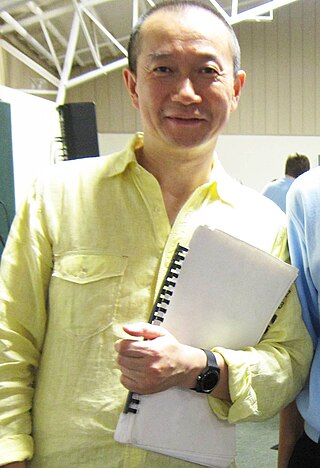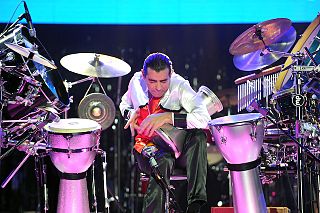Related Research Articles

Music is the arrangement of sound to create some combination of form, harmony, melody, rhythm, or otherwise expressive content. Music is generally agreed to be a cultural universal that is present in all human societies. Definitions of music vary widely in substance and approach. While scholars agree that music is defined by a small number of specific elements, there is no consensus as to what these necessary elements are. Music is often characterized as a highly versatile medium for expressing human creativity. Diverse activities are involved in the creation of music, and are often divided into categories of composition, improvisation, and performance. Music may be performed using a wide variety of musical instruments, including the human voice. It can also be composed, sequenced, or otherwise produced to be indirectly played mechanically or electronically, such as via a music box, barrel organ, or digital audio workstation software on a computer.

A musical ensemble, also known as a music group, musical group, or a band is a group of people who perform instrumental and/or vocal music, with the ensemble typically known by a distinct name. Some music ensembles consist solely of instrumentalists, such as the jazz quartet or the orchestra. Other music ensembles consist solely of singers, such as choirs and doo-wop groups. In both popular music and classical music, there are ensembles in which both instrumentalists and singers perform, such as the rock band or the Baroque chamber group for basso continuo and one or more singers. In classical music, trios or quartets either blend the sounds of musical instrument families or group instruments from the same instrument family, such as string ensembles or wind ensembles. Some ensembles blend the sounds of a variety of instrument families, such as the orchestra, which uses a string section, brass instruments, woodwinds, and percussion instruments, or the concert band, which uses brass, woodwinds, and percussion. In jazz ensembles or combos, the instruments typically include wind instruments, one or two chordal "comping" instruments, a bass instrument, and a drummer or percussionist. Jazz ensembles may be solely instrumental, or they may consist of a group of instruments accompanying one or more singers. In rock and pop ensembles, usually called rock bands or pop bands, there are usually guitars and keyboards, one or more singers, and a rhythm section made up of a bass guitar and drum kit.

An orchestra is a large instrumental ensemble typical of classical music, which combines instruments from different families. There are typically four main sections of instruments:

Orchestration is the study or practice of writing music for an orchestra or of adapting music composed for another medium for an orchestra. Also called "instrumentation", orchestration is the assignment of different instruments to play the different parts of a musical work. For example, a work for solo piano could be adapted and orchestrated so that an orchestra could perform the piece, or a concert band piece could be orchestrated for a symphony orchestra.

Musical composition can refer to an original piece or work of music, either vocal or instrumental, the structure of a musical piece or to the process of creating or writing a new piece of music. People who create new compositions are called composers. Composers of primarily songs are usually called songwriters; with songs, the person who writes lyrics for a song is the lyricist. In many cultures, including Western classical music, the act of composing typically includes the creation of music notation, such as a sheet music "score", which is then performed by the composer or by other musicians. In popular music and traditional music, songwriting may involve the creation of a basic outline of the song, called the lead sheet, which sets out the melody, lyrics and chord progression. In classical music, orchestration is typically done by the composer, but in musical theatre and in pop music, songwriters may hire an arranger to do the orchestration. In some cases, a pop or traditional songwriter may not use written notation at all and instead compose the song in their mind and then play, sing or record it from memory. In jazz and popular music, notable sound recordings by influential performers are given the weight that written or printed scores play in classical music.
Sheet music is a handwritten or printed form of musical notation that uses musical symbols to indicate the pitches, rhythms, or chords of a song or instrumental musical piece. Like its analogs – printed books or pamphlets in English, Arabic, or other languages – the medium of sheet music typically is paper. However, access to musical notation since the 1980s has included the presentation of musical notation on computer screens and the development of scorewriter computer programs that can notate a song or piece electronically, and, in some cases, "play back" the notated music using a synthesizer or virtual instruments.

IRCAM is a French institute dedicated to the research of music and sound, especially in the fields of avant garde and electro-acoustical art music. It is situated next to, and is organisationally linked with, the Centre Pompidou in Paris. The extension of the building was designed by Renzo Piano and Richard Rogers. Much of the institute is located underground, beneath the fountain to the east of the buildings.

Tan Dun is a Chinese-born American composer and conductor. A leading figure of contemporary classical music, he draws from a variety of Western and Chinese influences, a dichotomy which has shaped much of his life and music. Having collaborated with leading orchestras around the world, Tan is the recipient of numerous awards, including a Grawemeyer Award for his opera Marco Polo (1996) and both an Academy Award and Grammy Award for his film score in Ang Lee's Crouching Tiger, Hidden Dragon (2000). His oeuvre as a whole includes operas, orchestral, vocal, chamber, solo and film scores, as well as genres that Tan terms "organic music" and "music ritual."
Julian Anderson is a British composer and teacher of composition.

In music, transcription is the practice of notating a piece or a sound which was previously unnotated and/or unpopular as a written music, for example, a jazz improvisation or a video game soundtrack. When a musician is tasked with creating sheet music from a recording and they write down the notes that make up the piece in music notation, it is said that they created a musical transcription of that recording. Transcription may also mean rewriting a piece of music, either solo or ensemble, for another instrument or other instruments than which it was originally intended. The Beethoven Symphonies transcribed for solo piano by Franz Liszt are an example. Transcription in this sense is sometimes called arrangement, although strictly speaking transcriptions are faithful adaptations, whereas arrangements change significant aspects of the original piece.

En saga, Op. 9, is a single-movement tone poem for orchestra written from 1891 to 1892 by the Finnish composer Jean Sibelius. The piece, which likely began as a septet or octet for flute, clarinet, and string ensemble before evolving into an orchestral tone poem, premiered on 16 February 1893 in Helsinki with Sibelius conducting the Helsinki Orchestral Association. A decade later in 1902, Sibelius substantially revised En saga in response to an invitation from Ferruccio Busoni to conduct the piece in Berlin. It thus stands alongside The Lemminkäinen Suite (Op. 22), the Violin Concerto (Op. 47), The Oceanides (Op. 73), and the Fifth Symphony (Op. 82) as one of the most overhauled works in his œuvre. The Berlin concert, which occurred a fortnight after Robert Kajanus had premiered the revised version in Helsinki on 2 November, finally brought Sibelius the German breakthrough he had long desired.

Vinko Globokar is a French-Slovenian avant-garde composer and trombonist.

Rony Barrak is a Lebanese darbouka player and composer. He began playing the darbouka at four.
Đuro Živković, also rendered as Djuro Zivkovic, is a Serbian-Swedish composer and violinist. He has lived in Stockholm, Sweden, since 2000.

The Orchestral Tubular Bells is an orchestral version of Mike Oldfield's album Tubular Bells, arranged by David Bedford and recorded in 1974 by the Royal Philharmonic Orchestra, featuring Oldfield himself playing the guitar. Excerpts from the album were featured in the 1979 NASA film The Space Movie. It peaked at #17 on the UK Albums Chart in 1975.

Timothy Wesley John Brady is a Canadian composer, electric guitarist, improvising musician, concert producer, record producer and cultural activist. Working in the field of contemporary classical music, experimental music, and musique actuelle, his compositions utilize a variety of styles from serialism to minimalism and often incorporate modern instruments such as electric guitars and other electroacoustic instruments. His music is marked by a synthesis of musical languages, having developed an ability to use elements of many musical styles while retaining a strong sense of personal expression. Some of his early recognized works are the 1982 orchestral pieces Variants and Visions, his Chamber Concerto (1985), the chamber trio ...in the Wake..., and his song cycle Revolutionary Songs (1994).
Variations for Winds, Strings and Keyboards is an orchestral piece composed in 1979 by Steve Reich. The piece is scored for oboes, flutes, full brass, strings, pianos, and electric organs. Variations was Reich's first orchestral piece.
Markus Reuter is a German multi-instrumentalist, composer, record producer and instrument designer.

The Boulder Philharmonic Orchestra, founded in 1958, is a professional symphony orchestra based in Boulder, Colorado. It is led by Music Director Michael Butterman. The Boulder Philharmonic's season at Macky Auditorium on the University of Colorado at Boulder campus and other venues includes classical music, pops, school and family concerts, as well as an annual production of The Nutcracker with Boulder Ballet.

David Flynn is an Irish composer, musician, and the founder and artistic director of the Irish Memory Orchestra. Many of his works music merge the influence of traditional Irish music with contemporary classical music and jazz. He is also a multi-instrumentalist who works across many genres including classical, jazz, rock and traditional Irish music, with guitar being his main instrument.
References
- ↑ Markus Reuter official biography timeline Archived 2012-08-03 at the Wayback Machine
- 1 2 'Fifteen Questions with Markus Reuter' (interview on Fifteen Questions website)
- 1 2 Biography on 'Todmorden 513' microsite Archived 2013-11-02 at the Wayback Machine
- 1 2 Iapetus Media press release for Todmorden 513
- 1 2 3 Three Pieces feature on Markus Reuter
- 1 2 3 "Markus Reuter: Piece 2: Todmorden 513" (Three Pieces YouTube feature)
- 1 2 3 Dr. Mary C. Jungerman's musical analysis of "Todmorden 513" Archived 2013-11-03 at the Wayback Machine
- 1 2 3 Markus Reuter interview on 'More Gilles' program, Colorado Public Radio, April 16, 2013 (text and content from audio broadcast)
- ↑ Thomas A. Blomster: 'Welcome' (Todmorden blog) Archived 2016-03-03 at the Wayback Machine
- ↑ Thomas A. Blomster: 'More News & Thoughts' (Todmorden blog) Archived 2016-03-03 at the Wayback Machine
- ↑ DMA Music report on "Todmorden 513" concert
- ↑ OpusColorado reports "Todmorden 513" premiere, April 12, 2013
- ↑ Album notes from discogs.com
- ↑ Further album notes from discogs.com
- ↑ Artwork at ritxiostariz.com
- ↑ Todmorden blog - "Countdown 9" Archived 2013-12-08 at the Wayback Machine
- ↑ Todmorden blog - "Countdown 7" Archived 2013-12-08 at the Wayback Machine